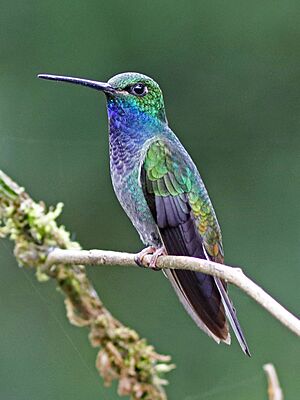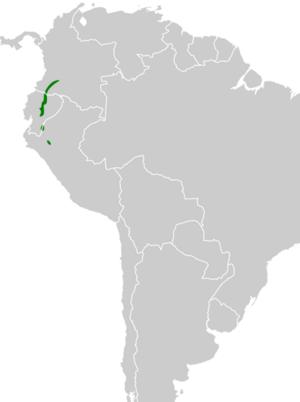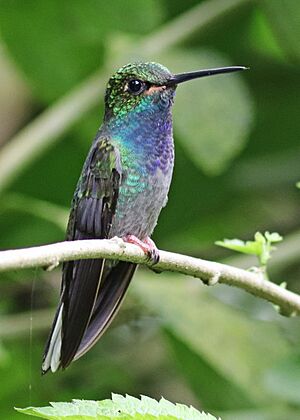Green-backed hillstar facts for kids
Quick facts for kids Green-backed hillstar |
|
|---|---|
 |
|
| Conservation status | |
| Scientific classification | |
| Genus: |
Urochroa
|
| Species: |
leucura
|
 |
|
The green-backed hillstar (Urochroa leucura) is a type of hummingbird found in the beautiful mountains of Colombia, Ecuador, and Peru. It's known for its bright colors and quick movements. This bird was once thought to be the same as another hummingbird, the white-tailed hillstar, but scientists now know they are different species.
Contents
About the Green-backed Hillstar
The green-backed hillstar and the rufous-gaped hillstar (Urochroa bougueri) are the only two birds in their special group, called a genus. Even though they share the name "hillstar" with other birds in the Oreotrochilus genus, they are not closely related. The green-backed hillstar is a unique species, meaning it doesn't have different subspecies.
What Does It Look Like?
This hummingbird is about 13 to 14 centimeters (about 5 to 5.5 inches) long. Its long bill is about 3 centimeters (1.2 inches) by itself! It weighs around 8.7 grams (0.3 ounces), which is super light.
Both male and female green-backed hillstars look quite similar. They have shiny, bronzy-green feathers on their backs. Their throats and chests are a beautiful iridescent blue, which means they shimmer with different colors in the light. Their bellies are a dull gray. The central feathers of their tail are bronzy, while the outer ones are white with dark gray edges.
Young green-backed hillstars look a lot like the adults. They might have some buffy (light yellowish-brown) edges on their head feathers and a small buffy streak on their cheeks.
Where Does It Live?
You can find the green-backed hillstar on the eastern side of the Andes mountains. They live from southern Colombia, through eastern Ecuador, and in some parts of northeastern Peru.
These birds like to live inside and at the edges of old, grown-up mountain forests. They also live in younger forests that are growing back, and on bushy hillsides. You can often spot them near streams. In Colombia and Ecuador, they usually live at elevations between 1,600 and 2,800 meters (about 5,200 to 9,200 feet) above sea level. They are most common around 1,800 meters (about 5,900 feet). In Peru, they are found at lower elevations, between 800 and 1,500 meters (about 2,600 to 4,900 feet).
How Does It Behave?
Movement
While green-backed hillstars generally stay in one area, they do move up and down the mountains depending on the season.
Feeding Habits
These hummingbirds usually look for food in the lower and middle parts of the forest. Sometimes, they even go up to the very top of the trees! Male birds will protect areas where there are lots of flowers, making sure they have enough nectar to eat. They mostly drink nectar from plants like Inga, Bomarea, Psammisia, and Cavendishia. Besides nectar, they also catch small insects by flying out from a perch and grabbing them in the air.
Reproduction
Scientists don't have much information about how the green-backed hillstar reproduces or its breeding habits.
What Does It Sound Like?
The song of the green-backed hillstar is thought to be a continuous series of single notes that sound like 'tseee', 'tsing', or 'seeuw'. They also make a liquid 'twit' sound, which they repeat many times in a row.
Conservation Status
The IUCN (International Union for Conservation of Nature) has listed the green-backed hillstar as a species of "Least Concern." This means they are not currently in danger of disappearing. However, we don't know exactly how many of these birds there are or if their numbers are changing. No immediate threats to their survival have been found. They are considered fairly common in Colombia, but less common or rare in Ecuador, and rare and found only in specific places in Peru.



